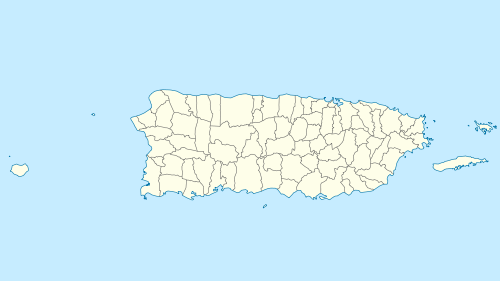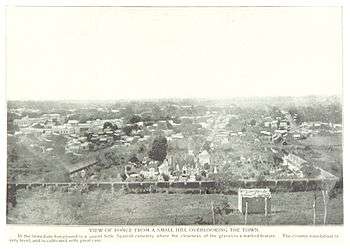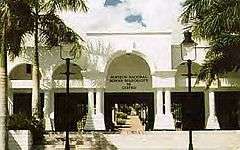Panteón Nacional Román Baldorioty de Castro
|
Cementerio Antiguo de Ponce | |
|
The Panteón Nacional Román Baldorioty de Castro, previously known as Cementerio Antiguo de Ponce (looking north) | |
 Location of Ponce and the cemetery in Puerto Rico | |
| Location | Torres no. 1 and Frontispicio St., Ponce, Puerto Rico |
|---|---|
| Coordinates | 18°00′57″N 66°37′04″W / 18.015833°N 66.617778°WCoordinates: 18°00′57″N 66°37′04″W / 18.015833°N 66.617778°W |
| Area | 3.7 acres (1.5 ha) |
| Built | 1842 |
| Architect | Nieto Blajol Iglesia (1864 project) |
| Architectural style | Neoclassical |
| NRHP Reference # | 84003149[1] |
| Added to NRHP | January 5, 1984 |
 Location in Puerto Rico | |
| Established | 1992 |
|---|---|
| Location | Torres no. 1 &Frontispicio St., Ponce, Puerto Rico |
| Type | Cemetery Museum |
| Owner | Autonomous Municipality of Ponce |
The Panteón Nacional Román Baldorioty de Castro (English: Román Baldorioty de Castro National Pantheon) is a tract of land in Barrio Segundo of the city of Ponce, Puerto Rico, originally designed as the city's cemetery, but later converted into what has come to be a famous burial place. Established in 1842, it is Puerto Rico's first (and only) national pantheon.[2][3] It is the only cemetery dedicated as a museum in Puerto Rico and the Caribbean.[4] Prior to being dedicated as a Panteon Nacional, it was known as Cementerio Viejo or as Cementerio Antiguo de Ponce, and is listed under that name on the U.S. National Register of Historic Places. The Pantheon is named after Román Baldorioty de Castro, a prolific Puerto Rican politician, and firm believer of Puerto Rican autonomy and independence. His remains are located here.[2] The Pantheon also houses a small museum about the history of autonomism in the Island, and it is currently used both as a park and a venue for the expression of culture and the arts.[5] It is called the Museo del Autonomismo Puertorriqueño.
Prior to being turned into a National Pantheon in 1991, it was known as Ponce's Old Cemetery, to differentiate it from the newer (though now also over 100 years old) Cementerio Civil de Ponce (Ponce Civil Cemetery).[6] Built in 1842, the cemetery was enlarged in 1864.
History

On February 13, 1838, the secretary of the Municipality of Ponce met with civic leaders of the "Villa of Ponce" to discuss plans for building a new cemetery. The existing cemetery was in deplorable and bad condition, and it posed a danger to public health. Because the "Villa of Ponce" did not have the money to build the cemetery, a voluntary proportional contribution was established in which all neighbors were to contribute. A commission was named composed of one member of the Municipal Council and four neighbors of influence to open up a voluntary subscription, name a depository and to proceed with the construction of the cemetery until its completion. The project was to be carried out in a lot adjacent to the existing cemetery extending one hundred square "varas" (a measure of length equal to 0.84m. approximately). Named by vote to form the commission were the "Sor Sindico" '(secretary to the mayor of the "Villa") and the neighbor leaders Don Geronimo Ortiz, Don Tomas Souffront, Don Luis Font, and Don Mateo Maenamaxe. On February 26, 1838, the project was approved by the mayor of Ponce. However, it was not until 1842 that the project was started out with the contributions of the neighbors of the "Villa". In 1843, the cemetery was inaugurated under the auspices of the mayor of Ponce, Don Juan Rondon Martinez, which by the way, was the first person to be buried there. In 1864 the cemetery was enlarged and repaired. The new work consisted of repairs and construction of the enclosing walls and pathways, construction of new niches and construction of a chapel and mortuary. In 1915 the cemetery was closed down.[7]
Architecture and construction
The cemetery consisted of well-designed small mausoleums that were lined up following a central pathway followed by lateral ones, starting from the entrance of the cemetery to a chapel located at the end. Most structures were designed and constructed following the neoclassical style that prevailed at that time. This style consisted of the use of columns and pilasters following the Doric, Ionic or Corinthian order, barrel vaults, Greek pediments, Roman arches and other details characteristic of said style. The thick walls and piers were built using brick, mortar, and "argamasa" (a mixture of crushed brick, sand, stone aggregate and lime). The enclosing walls were built of brick and mortar, and the part of the walls built in 1864 were built using stone and mortar. It was built in 1842 and enlarged in 1864.[7]
Significance
This cemetery distinguishes itself because various illustrious Puerto Ricans of transcendental importance are buried here. The most important personage buried in this historic cemetery is Don Román Baldorioty de Castro, distinguished patriot, journalist, educator, writer, orator, and abolitionist. In 1870, he was elected delegate to the Courts of Cadiz, where he attacked the slavery system of the time, being responsible for most of the liberty amendments. Afterward, on March 23, 1873, the abolition of slavery was proclaimed, being Baldorioty de Castro responsible for such proclamation.[7]
Also buried there are Don Juan Seix, founder of the Ponce Fire Department, and Don Juan Rondon Martinez, mayor of Ponce, founder of the cemetery and first person buried there.[7] Another prominent mayor buried there is Salvador de Vives, who also founded Hacienda Buena Vista.[8] Other distinguished persons buried there are: Juan Morel Campos and Manuel G. Tavarez, distinguished composers and musicians, most famous for their danzas (folkloric music typical of Puerto Rico) compositions,[7] and tenor of kings Antonio Paoli.[9][10] The remains of nationalist heroe Casimiro Berenguer are buried here as well.[11] There are also members of the prominent Seralles family,[12] founders of the Destileria Serralles, and after whom the Castillo Serralles took its name.[13] Ex-governor Roberto Sanchez Vilella's tomb is also found here[14] and the late mayor of Ponce, Rafael Cordero Santiago, has a mausoleum here as well.[15]
Physical appearance

The cemetery plan is shaped as a rectangle measuring approximately 157.71 meters in length by 84.31 meters wide. It is attached to a rectangular-shaped lot at the northeast corner measuring about 32.80 meters in length by 25.03 meters wide, and a small rectangular lot where the mortuary used to be located, at the center of the south side of cemetery measuring about 14.13 meters wide by 8.97 meters in length.[16]
A small mortuary structure building used to stand at the entrance of the cemetery. Following this structure, small mausoleums, crypts and niches were lined up on a central pathway that led to a small chapel located at the center of the cemetery. The cemetery was totally enclosed by very high walls that still remain. Most mausoleums and crypts were constructed following the neo-classical style trend that prevailed at the time. Thick walls and piers were used as the main structural system. These were constructed using brick/"argarnasa", stone and mortar.[16]
The cemetery was closed in 1915 and it deteriorated since then. By 1984, it became subjected to vandalism; crypts and mausoleums were plundered. On that year, it contained a variety of mausoleums, crypts and niches partially destroyed, and most of the cemetery was covered by heavy vegetation. The enclosing wall plaster had fallen down exposing the brick and stone to weather conditions.[16]
Around 1990, the city of Ponce managed to salvage it. It repaired and reconstructed it, turning it into a National Pantheon. The cemetery was called Cementerio Viejo (English: Old Cemetery), but at that point it was renamed Panteón Nacional Román Baldorioty de Castro (English: Román Baldorioty de Castro National Pantheon). It also established a small museum about autonomism. The city has also commissioned the Pontifical Catholic University of Puerto Rico School of Architecture to perform a study to determine the viability and cost for the total reconstruction of the Pantheon.
Current use
The cemetery is not active for the burial of just-deceased illustrious people as it does not have an order by the Puerto Rico Department of Health to operate in that mode due to the propensity of the terrain for landslides.[17] Instead, it is used to transfer remains after a period of five years has lapse.[18] As of April 2014, the most recently transferred remains were those of Madeleine Velasco Alvarado in 2008, Rafael Cordero Santiago in 2004, and Simon Moret Gallart in 1998.[19] In April 2014 the possibility of interment of the remains of Cheo Feliciano was being considered. Ponce Mayor Maria Melendez stated she would issue a municipal order to transfer Feliciano's remains to the Panteon,[20] if possible after one year.[21]
See also
References
- ↑ National Park Service (2009-03-13). "National Register Information System". National Register of Historic Places. National Park Service.
- 1 2 The World of 1898, The Spanish-American War
- ↑ Aproximación a la iconografía funeraria en Puerto Rico: Análisis de Tumbas y Pinturas Puertorriqueñas Representativas de Finales del Siglo XIX al Inicio del XXI. Doctoral Thesis. By Doris E. Lugo Ramirez. ISBN 978-84-691-7947-5. Universidad de Sevilla, Sevilla, España. 2008. Page 112.
- ↑ Juan Alindato y Chegüi Torres al Panteon Nacional Roman Baldorioty de Castro, nuestro cementerio museo. Periodico "La Voz de la Playa de Ponce", Edicion 131, October 2010. Page 2.
- ↑ Cine y jazz en el Panteón Román Baldorioty de Castro de Ponce. El Sur a la Vista. 13 September 2011. Retrieved 4 October 29011.
- ↑ Renamed National Pantheon in 1991
- 1 2 3 4 5 State Historic Preservation Officer, Certifying Official; Armando Morales Pares, Architect, Puerto Rico Historic Preservation Office. (San Juan, Puerto Rico) November 25, 1983. In National Register of Historic Places Inventory - Nomination Form. United States Department of the Interior. National Park Service. (Washington, D.C.) Page 3. Listing Reference Number 84003149. January 5, 1984.
- ↑ Tavarez and De Vives
- ↑ Tenor of Kings
- ↑ Paoli also buried there.
- ↑ Panteon Nacional Roman Baldorioty de Castro. Official Website of the Autonomous Municipality of Ponce.
- ↑ Let's Go. Southeast Ponce. Let's Go Travel.
- ↑ Serralles also buried there
- ↑ Governor Sanchez Vilella also buried there.
- ↑ Bonnin Orozco Architects (Ponce, Puerto Rico). Public Spaces Projects. Mausoleo Rafael Cordero Santiago.
- 1 2 3 State Historic Preservation Officer, Certifying Official; Armando Morales Pares, Architect, Puerto Rico Historic Preservation Office. (San Juan, Puerto Rico) November 25, 1983. In National Register of Historic Places Inventory - Nomination Form. United States Department of the Interior. National Park Service. (Washington, D.C.) Page 2. Listing Reference Number 84003149. January 5, 1984.
- ↑ ‘Mayita’ perpetuará memoria de ‘Cheo’. Yomaris Rodríguez. EL VOCERO. 22 April 2014.
- ↑ Puerto Rico le da el último adiós a Cheo Feliciano. NotiUno. 21 April 2014.
- ↑ Ponce: lloran partida de Cheo Feliciano. Reinaldo Millán and Jason Rodríguez Grafal. La Perla del Sur. Ponce, Puerto Rico. 17 Abril 2014.
- ↑ Alcaldesa confirma que Cheo Feliciano tendrá un velatorio de pueblo. Presencia. 17 April 2014.
- ↑ Velatorio de Cheo Feliciano será este fin de semana. Inter News Service. 17 April 2014
